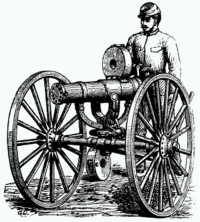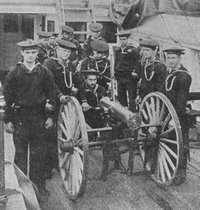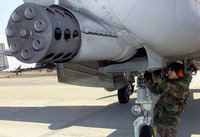Gatling gun
|
|
The Gatling gun was the first successful machine gun. Unlike previous devices it was the first to combine reliability, high firing rate and ease of loading into a single device. It was designed by the American inventor Richard J. Gatling in 1861 and patented on May 9, 1865. In modern use it often refers to guns of similar rotating barrel design.
GatlingGunDrawing.jpg
| Contents |
History of the gun
The gun was patented in 1861 during the Civil War ("Gatling Gun (1861) History of the Gatling Gun"). In 1862 the U.S. government didn't buy any Gatling guns because they did not have a trigger and were way too heavy for to be setup quickly. Even when Gatling made improvements it still did not have a trigger and the lightest one weighed over 90 lb. However, Union General Benjamin Butler bought 12 and they were used successfully on the Petersburg front (Niepert 1). The first time they were used, both Yankees and Rebels were awestruck by their power and effect. Unfortunately, they were only in service late in the war by the Northern army. Originally Gatling was a Southern sympathizer but the Union seized the blueprints and southern factories did not have the equipment to build the guns (Brooks 54). If the gun had been used more often and earlier in the war, it probably would have been over much faster.
The event paragraph for the Gatling gun is how it worked. The Gatling gun, nicknamed the "Coffee-Mill gun" by Abraham Lincoln (Richie 78), was hand-crank operated with six barrels (so the gun didn't over heat) revolving around a central shaft [1] (http://www.civilwarhome.com/gatlinggun.htm). The bullets were fed to the gun by gravity through a hopper on top of the gun. However, Gatling wasn't the first one who thought of the grouped barrel idea; it originated in the 18th century. Each barrel had its own firing mechanism. Each cartridge holder was divided into 16 sections each holding 25 cartridges. After 1861, new brass bullet cartridges similar to modern cartridges replaced the paper cartridge (Richie 78-79). When the new bullets were introduced, Gatling didn't switch to them immediately (Richie 79). One problem before the switch to brass cartridges was that firing the gun produced a large cloud of smoke, obscuring the gunner's sight.
The model of 1881 was designed to use the Bruce feed system that would accept .45/70 cartridges (Hoffman 24). The advantage of the Bruce system is that while one track was feeding the gun, another person could be loading the other track for continuous fire (Hoffman 24). A problem was that at the end of the barrel it was wider; as a result, it was not always accurate (Stewart 80). To fix the problem of inaccuracy Gatling switched to rim fire bullets, but it was too late (Stewart 80). It took four people to operate. By 1876 the Gatling gun could fire 1,200 rounds per minute, although 400 was more reasonable (Richie 79).
Basic Design
The gun was a hand-driven rotary device, powered using a crank. A cylinder of ten barrels would be loaded and fired for each revolution. The gun was produced in calibres ranging from one inch down to 0.45 inch. It was operated by a crew of four.
The barrels, a carrier, and a lock cylinder were separate and all mounted on a solid plate revolving around a central shaft, mounted on an oblong fixed frame. The carrier was grooved and the lock cylinder was drilled with holes corresponding to the barrels. Each barrel had a single lock, working in the lock cylinder on a line with the barrel. The lock cylinder was encased and joined to the frame. The casing was partitioned, through this opening the barrel shaft was journaled. In front of the casing was a cam with spiral surfaces. The cam imparted a reciprocating motion to the locks when the gun rotated. Also in the casing was a cocking ring with projections to cock and fire the gun.
DSCN5243_ftlaramiegatlinggun_e.jpg
Turning the crank rotated the shaft. Cartridges, held in a hopper, dropped individually into the grooves of the carrier. The lock was simultaneously forced by the cam to move forward and load the cartridge and when the cam was at its highest point the cocking ring freed the lock and fired the cartridge. After the cartridge was fired the continuing action of the cam drew back the lock bringing with it the spent cartridge which was then dropped to the ground.
The grouped barrel concept was not new, it had been tried since the 18th century, but poor engineering and the lack of a unitary cartridge made previous designs unsuccessful. The innovative features of the Gatling gun were its independent firing mechanism for each barrel and the simultaneous action of the locks, barrels, carrier and breech.
The smallest calibre gun also had a Broadwell drum feed in place of the curved magazine of the other guns. The cartridge holder was divided into sixteen sections each holding 25 cartridges. As each section was emptied the drum rotated bringing a new section into use until all 400 rounds had been fired.
The concept was made obsolete with the development of the gas or recoil blowback concept, which is the basis of modern machine guns.
Combat use
The Royal Navy adopted them for use on board ships. The Naval Brigades serving during the Zulu Wars used them alongside their artillery and they also saw action during the bombardment of Alexandria in 1882.
Modern Gatling Guns
Although the principle was unused for many years, Gatling-style guns with rotating barrels were to return with the requirement for very high rate-of-fire weapons in military aircraft and ship-based anti-missile defence systems, with electric motors replacing mechanical cranks for rotation. One example is the M61 Vulcan 20 mm cannon, the most commonly used member of a family of weapons designed by General Electric. The Vulcan is a six-barrelled electric Gatling capable of firing more than 6,000 rounds per minute, a rate unachievable with a conventional machine gun. A variety of similar weapons are available in calibers ranging from 5.56 mm to 30 mm, the rate of fire being somewhat proportional to the size and mass of the ammunition (which also determines the size and mass of the barrels). During the Vietnam War The M134 Minigun was created for helicopters as an offensive and defensive weapon, able to fire 4,000 rounds a minute the Minigun proved to be one of the deadliest weapons ever built and is implemented in helicopters today. The gun was also made famous in the Arnold Schwarzenegger movie Predator where the character played by Jesse Ventura was armed with a M134 Minigun, though it is impossible for a single person to actually carry and fire the Minigun because of hundreds of pounds of backpressure.
See also
External links
- List of Military Gatling & Revolver cannons (http://www.canit.se/~griffon/aviation/text/akandata.htm)
- Template:US patent -- Gatling gun
- http://www.world.guns.ru/machine/minigun-e.htmde:Gatling-Kanone



